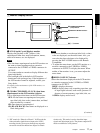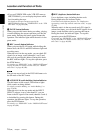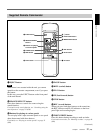
18 (GB) Chapter 1 Overview
Location and Function of Parts
Chapter 1 Overview
Rear Panel
1 OUTPUT connectors
Used to output analog video and audio signals. To
connect a device equipped with S-video input, use the
S VIDEO connector on the unit.
When the CHARACTER DISPLAY switch is set to
ON, data items, such as time data, menus, and
warnings, are superimposed on a monitor connected to
the S VIDEO and the VIDEO connectors.
For details on the superimposed data items, see
“Displaying Various Data” on page 23 (GB).
The audio output level of this unit is 2 Vrms (full bit).
When the AUDIO OUTPUT SELECT selector is set
to MIX, that drops to 50 % (–6 dB).
Notes
•Data items superimposed on a monitor connected to
these connectors are the same as those superimposed
on the LCD monitor.
You cannot make two monitors display different data
items individually.
• If you want to output video signals without text data,
carry out the following operations.
– Set the CHARACTER DISPLAY switch on the
front panel to OFF.
– Set TITLE DISP and LABEL DISP on the CM
SET menu to OFF.
–Depending on the displayed items, press the DATA
CODE or SEARCH SELECT button on the
Remote Commander to clear the text data on the
monitor screen.
For details on text data, see “Displaying Various Data”
on page 23 (GB).
For details on the CM SET menu, see “CM SET menu” on
page 58 (GB).
• In the EE mode (when the input signal is output as an
analog signal) or during recording, the subcarrier of
the color signal is not synchronized with the
horizontal sync signal. The color of the picture or the
horizontal sync signal may be distorted depending on
the type of monitor connected to the unit.
• Sync and burst signals of the EE pictures output via
these connectors are not synchronized.
• If DV input has been selected, color and luminance
may be distorted in the EE mode, depending on the
monitor.
• The unit only can accept standard video signals.
If you input the types of video signals shown below,
recorded picture, sound and the EE picture output via
these connectors may be distorted.
– Signals from some home game machines
–Blue background screen or gray background screen
from a consumer VCR
– Pictures played at a speed other than normal by a
VCR that does not have the TBC (Time Base
Corrector)
–Video signals in which the sync signals are
distorted
– Signals from a defective cassette (tape or recording
condition is bad) played by an analog VCR that
does not have TBC
1 OUTPUT connectors
2 INPUT connectors
3 AUDIO INPUT LEVEL
selector
4 NTSC/PAL select switch
5 DV jack
6 AC IN connector
7 CONTROL S IN
jack
8 LANC jack


















